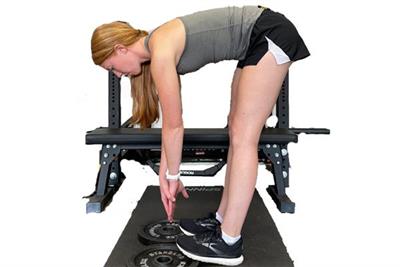 We often associate the inability to touch our toes with tight hamstrings. While the Toe Touch Test is a great test for overall mobility in the spine and hamstrings, it can also help identify a hip problem versus a lower back/core limitation. We often associate the inability to touch our toes with tight hamstrings. While the Toe Touch Test is a great test for overall mobility in the spine and hamstrings, it can also help identify a hip problem versus a lower back/core limitation.
We aren’t just looking for whether or not you can touch your toes. We also want to see your ability to demonstrate good hip hinge or forward bend. This range of motion is important for golfers because any restriction in hip hinge mechanics can lead to poor address and dynamic posture. Players will tend to get too rounded from the spine or have excessive knee bend to make up for limited hip bend. How to Perform a Toe Touch Test Begin by standing with your feet together and toes pointing forward. Bend from the hips forward and try to touch the ends of the fingers to the tips of the toes, without bending the knees. If you have a limitation in the toe touch you will perform the same test but just one leg at a time. This time raise one of the heels slightly off the ground by using a lift of some sort (phone book, mat etc.). This will cause a slight bend in one knee while the other remains straight. Bend over and touch the toes of the straight leg. Repeat on the opposite side. This test can indicate several physical flaws: The first is an inflexibility of the hamstring muscle group, which will prevent you from keeping the knees straight. Inflexibility is very common in males. The second is an improper forward flexion pattern. Many golfers try to bend forward from their back (upper, mid and low) instead of flexing forward from the hip sockets. Sometimes limitation comes from immobility in the hip joints. Arthritic hips, cartilage or capsular tears or hip joint musculature restrictions can cause a failed Toe Touch Test as well. Typically, we will see a limitation on one side but not the other in hip joint limitations. If there is a limitation in the toe touch on both legs we start with our toe touch progression exercises. The exercises are very simple. You perform the same movement as the test but with the toes elevated slightly and again with the heels elevated slightly. This is a movement pattern exercise not a stretch, so you will repeat the movement with brief holds at the end each time. When the toes are elevated you are stressing the posterior chain to increase flexibility. When the heels are elevated it changes your center of gravity as you bend forward and forces you to perform a proper hip hinge or you will fall forward. | 
 We often associate the inability to touch our toes with tight hamstrings. While the Toe Touch Test is a great test for overall mobility in the spine and hamstrings, it can also help identify a hip problem versus a lower back/core limitation.
We often associate the inability to touch our toes with tight hamstrings. While the Toe Touch Test is a great test for overall mobility in the spine and hamstrings, it can also help identify a hip problem versus a lower back/core limitation. 